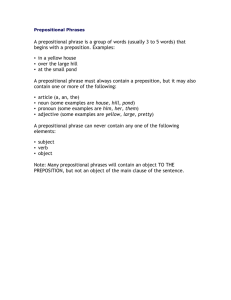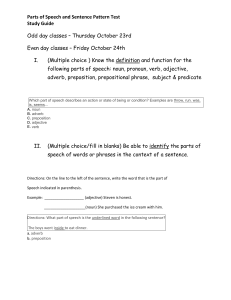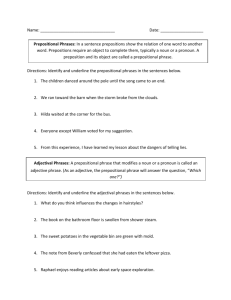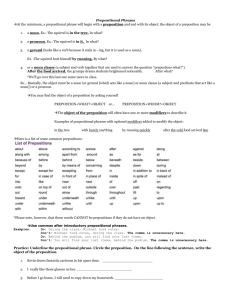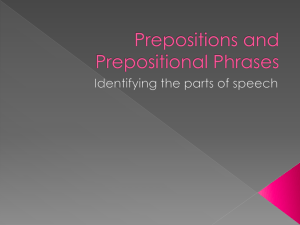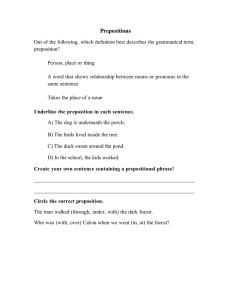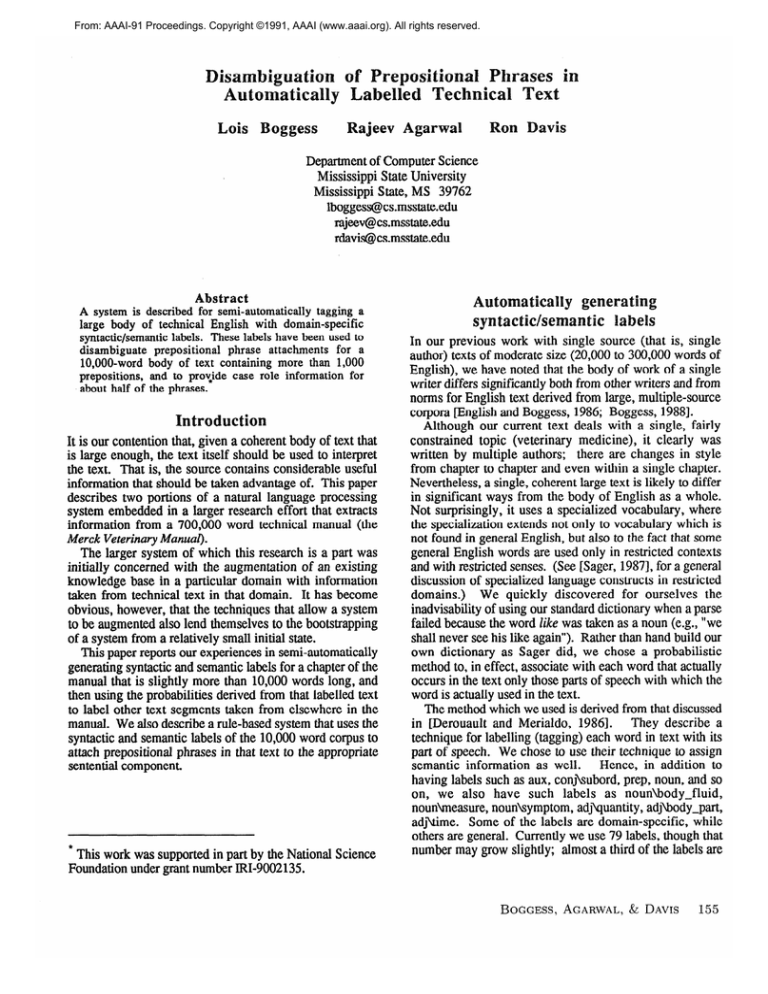
From: AAAI-91 Proceedings. Copyright ©1991, AAAI (www.aaai.org). All rights reserved.
ositio~a~ Phrases i
isambiguation
Automatka
of
Lois
Rajeev Agarwal
oggess
Department of Computer Science
Mississippi State University
Mississippi State, MS 39762
lboggess@cs.msstate.edu
rajeev@cs.msstate.edu
rdavis@cs.msstate.edu
Abstract
A system is described for semi-automatically tagging a
large body of technical English with domain-specific
syntactic/semantic labels. These labels have been used to
disambiguate prepositional phrase attachments for a
lO,OOO-word body of text containing more than 1,000
prepositions, and to proxide case role information for
about half of the phrases.
Introduction
It is our contention that, given a coherent body of text that
is large enough, the text itself should be used to interpret
the text. That is, the source contains considerable useful
information that should be taken advantage of. This paper
describes two portions of a natural language processing
system embedded in a larger research effort that extracts
information from a 700,000 word technical manual (the
Merck Veterinary Manual).
The larger system of which this research is a part was
initially concerned with the augmentation of an existing
knowledge base in a particular domain with information
taken from technical text in that domain. It has become
obvious, however, that the techniques that allow a system
to be augmented also lend themselves to the bootstrapping
of a system from a relatively small initial state.
This paper reports our experiences in semi-automatically
generating syntactic and semantic labels for a chapter of the
manual that is slightly more than 10,000 words long, and
then using the probabilities derived from that labelled text
to label other text segments taken from elsewhere in the
manual. We also describe a rule-based system that uses the
syntactic and semantic labels of the 10,000 word corpus to
attach prepositional phrases in that text to the appropriate
sentential component.
* This work was supported in part by the National Science
Foundation under grant number IRI-9002135.
In our previous work with single source (that is, single
author) texts of moderate size (20,000 to 300,000 words of
English), we have noted that the body of work of a single
writer differs significantly both from other writers and from
norms for English text derived from large, multiple-source
corpora English and Boggess, 1986; Boggess, 19881.
Although our current text deals with a single, fairly
constrained topic (veterinary medicine), it clearly was
written by multiple authors; there are changes in style
from chapter to chapter and even within a single chapter.
Nevertheless, a single, coherent large text is likely to differ
in significant ways from the body of English as a whole.
Not surprisingly, it uses a specialized vocabulary, where
the specialization extends not only to vocabulary which is
not found in general English, but also to the fact that some
general English words are used only in restricted contexts
and with restricted senses. (See [Sager, 19871, for a general
discussion of specialized language constructs in restricted
domains.)
We quickly discovered for ourselves the
inadvisability of using our standard dictionary when a parse
failed because the word Zike was taken as a noun (e.g., “we
shall never see his like again”). Rather than hand build our
own dictionary as Sager did, we chose a probabilistic
method to, in effect, associate with each word that actually
occurs in the text only those parts of speech with which the
word is actually used in the text.
The method which we used is derived from that discussed
in [Derouault and Merialdo, 19861. They describe a
technique for labelling (tagging) each word in text with its
part of speech. We chose to use their technique to assign
semantic information as well.
Hence, in addition to
having labels such as aux, conj\ubord, prep, noun, and so
on, we also have such labels as noun\bodyJluid,
nounbeasure, nounbymptom, adj\uantity, adjbody-part,
adj\time. Some of the labels are domain-specific, while
others are general. Currently we use 79 labels, though that
number may grow slightly; almost a third of the labels are
BOGGESS,
AGARWAL,
Jz DAVIS
155
singular/plural variants of noun labels; virtually all of the
semantic tags are associated with adjectives and nouns.
The process is described in [Davis, 19901. We hand
labelled an initial text of 2,000 words, and from this we
built Markov bigram and trigram source models of the label
sequences. (A Markov bigram model gives the probability
of a two-label sequence, given the presence of the first
label; a Markov trigram model gives the probability of a
three-label sequence, given the presence of the first two
labels.) The next 6,000 words of text were labelled
automatically, using the probabilities of the Markov
models to calculate which sequence of labels was most
probable for a given sentence. The 6,000 newly labelled
words of text were hand-corrected to give an 8,000 word
body of text, which was then used to generate new bigram
and trigram Markov models. Next the remainder of the
chapter was labelled automatically and hand-corrected.
In tagging new text, the probability that a sentence will
be labelled by a given sequence of tags is taken to be the
product of the probabilities of the individual words’ being
given their respective tags. If we were using only a trigram
model to compute the latter, they would be calculated as
follows: the probability that word wi would be labelled
with tag ti given that the preceding tags were t;-2 and 5-1
is computed as
This expression differs in the final term from the more
traditional p(WiI G-&-l)= p(t$t+2,4-1)X p(WiIt;)used
by Deroualt and Merialdo and others, and was suggested by
Church [Church, 19881. Over a sample of five test sets,
the Church method consistently gave us lower error rates usually an improvement of 3% (e.g. 16% instead of 19%).
Following the lead of Derouault and Merialdo, we
weighted the predictions of the bigram and trigram models,
with rather more emphasis given the bigram model. This
is necessary since a trigram model of n labels could
conceivably
have n2 + n1 + no states and O(n3)
connections. For n = 79, the 6321 states could hardly have
all been visited by 2,000 words of input.
The revised formula becomes
where Xl and hl are calculated by an iterative process
identical to that of Derouault and Merialdo.
Estimating
p(til ~1)
When a “known” word is encountered in the new text, we
estimate p&l wi) using the known distribution of tags for
that word. That is, if word wi has occurred with label ti x
times and word wi has occurred y times, then p(til wi) is
approximately x/y. (We say “approximately” because we
include a small probability that Wi may occur with a label
that we have not yet seen.)
For unknown words we use two heuristics: the simplest
is a “last resort” measure, used when there are no other cues
156
SYNTAX
AND
SEMANTICS
(number of occurrences of t$
P($l wi) = (occurrences of words outside the closed sets)’
More often, however, in dealing with an unknown word
we use suffix cues. A list of all tags encountered in words
ending in a two-letter pair, for &l two-letter combinations
encountered (not just traditional suffixes), is used to
estimate the probability for an unknown word ending in
that suffix. For example, if x occurrences of words ending
and if y
in -ie were labelled noun\pluraMisease_agent
occurrences of words ending in -ie have been encountered,
then p&l Wi) for words ending in -ie is estimated to be
approximately x/y, where again allowances are made for the
fact that the suffix may occur with a label that we have not
yet seen for it.
It should be mentioned that in dealing with new text, the
system is prohibited from hypothesizing that a new,
unknown word belongs to one of the closed classes.
Hence, adding a word to the closed classes requires human
intervention. -
pronouns
relative pronouns
possessive pronouns
auxiliaries
determiners
coordinate conjunctions
subordinate conjunctions
correlative conjunctions
Figure 1: Closed Classes
We have had to add to the “closed” classes rather more
often than we expected. For example, a number of apparent
compound prepositions were discovered in our text, some
of which may be prepositions only in our opinion, but
which clearly fit the use patterns of prepositions in our
source. Moreover, we have added the word “following” to
the set of prepositions, after our strong suspicions were
confirmed by the supplement to the Oxford English
Dictionary, which cites such usages beginning in the late
1940’s.
as soon as
as to
aswellas
because of
due to
in addition to
prior to
rather than
Figure 2: “compound” prepositions
Success rates and sources of error
Several 200-word excerpts of automatically tagged text were
examined. The results are as shown below. The first
sample was produced on the basis of Markov models of the
initial hand-tagged 2,000 word text the second sample was
produced on the basis of Markov models of 8,000 words of
hand-corrected text. Six additional samples were produced
on the basis of Markov models of the full lO,OOO-word
chapter of hand-corrected text. These latter samples came
from text tens of thousands of words apart and far from the
initial chapter, such that the subject matter was radically
different and the authors were almost certainly different as
well.
Part of Speech
Combined
Part of Speech/
Semantic Label
14%
Sample 1
6%
9%
Sample 2
6%
8%
Sample 3
4%
17%
10%
Sample 4
13%
Sample 5
5%
16%
Sample 6
5%
16%
Sample 7
7%
7%
Sample 8
2%
Figure 3: Error rates for labelled text
The error rate reported in [Derouault and Merialdo, 19861,
based on probabilities built from at least 47,000 words of
text that had been hand-corrected, was “less than 5 per
cent”. The labels applied appear to have been entirely
syntactic in nature. Our own labels have a part-of-speech
component, and if that portion is the only consideration,
then our present error rate is not much higher than theirs an average of 5.6% over the eight samples, based on a body
of only 10,000 words of text. Church 119881 reports an
error rate of 1% to 5%, depending on what one considers an
error, for a program performing syntactic labelling. It
seems likely that, with models based on more than 10,000
labelled words, our error rate for the syntactic labels will
fall within the latter range.
However, given the potential benefits of labels that are
both syntactic and semantic in nature, we are particularly
interested in the errors that occur in the semantic labelling.
It should be mentioned that determining what should be
called an “error” is not a straightforward process. In
general, we counted an error whenever a label was applied
by the system that differed from the label applied by a
human. There were two specific exceptions to this rule.
One had to do with the two semantic classifications
“disorder” and “symptom”; most terms which can be
classified as “disorder” in some contexts can be classified as
“symptom” in other contexts, and in a great many contexts
humans end up essentially flipping a coin in attaching one
or the other of the two labels. (A veterinarian and an M.D.
have confirmed that the difficulty in deciding between the
two semantic categories is not due to lack of expertise on
the part of the labellers.) The two terms were treated as
synonymous in calculating error rates. The other “break”
that we extended to the system was that on those relatively
few occasions when the system labelled a term with a
semantically more general label than the human, we treated
the label as correct. The reverse, however, was not true. In
the context of the larger system within which this research
was taking place, giving a word a correct but overly general
label (<noun> rather than <noun/treatment>, for example),
leaves the system with rather more work to do than the
more specific label would, but seldom would it cause the
system to make a mistake. On the other hand, a toospecific label (<noun/diagnostic-aid> when a human would
have Jabelled the word <noun>) might well lead the overall
system astray.
As it happens, the current version of the labelling
system is far more likely to commit the latter error. For
the samples reported above, more than one-third of all
errors reported above (and hence two-thirds of the semantic
labelling errors) have been due to over-specification
of
semantic type. Since the samples based on the full lO,OOOword probabilistic models were all taken from a different
chapter than the basis of the models, a fairly large
proportion of these errors were due to the fact that the
correct, specific semantic label had not been created. For
example, the label cnoun/bodyfunction> had not yet been
created for the system, because it had not been observed as a
useful label in the first chapter examined. Yet numerous
words that should have received such a label occurred in the
samples taken from outside that chapter. The human who
was labelling those words at the time simply chose to label
them <noun>. But the labelling system in almost every
case gave them more specific, hence erroneous, semantic
labels.
We expect to improve the error rates, then, by the
following means: Syntactic errors should decrease as a
result of larger bases for the Markov models. We are
experimenting with minor modifications of our heuristics
for estimating probabilities for unknown words. Adding
semantic categories that are clearly missing will lower the
semantic labelling errors to a significant degree, and we
also expect to address directly the question of how to
determine that a general label is preferable to a specific one.
We also are in the process of examining the degree of
improvement given by hand-labelling a small excerpt from
a new chapter, to be added to the larger Markov models,
prior to automatically labelling the rest of the new chapter.
All in all, we anticipate improving the error rates
substantially.
As described in [Agarwal, 19901, the first task assigned to
the syntactic/ semantic labels was that of disambiguating
prepositional phrases by attaching them to the appropriate
sentential components and assigning case roles to the
BOGGESS,
AGARWAL,
& DAVIS
157
sentence (word (if, conj\ubord),
noun-phmse (
the,det
signs,noun\glural)
verb-phrase (
correlate, verb)
with,prep
Prepghrase (
noun-phrase (
the,det
extra,adj~uantity
cilia, noun~lurabbody~part))
word (comma,punc)
noun-phrase (
excision~oun&atment)
of,prep
PreP-Phrase (
noun-phrase (
cilia,noun\pluraAbody_part))
verb-phrase (
is,aux
indicated,verb\9ast p))
Figure 4: Sample output from semi-parser.
resulting structures. The “cases” used in our system are an
extension of the more standard cases of case grammar, since
in our source the standard case roles account for very few of
the roles taken by prepositional phrases. Hence, we added
to such traditional roles as location, time, and instrument
such domain-specific roles as popuZation, disorder,
treatment, and the somewhat more general part-whole
CaSe.
For example,
the occurrence
of <verb> i n
<noun\body-pare receives a role designation of location,
while <verb> in <noun\patient> is designated population,
<noun\treatment>
of <noun\patient>
is considered
treatment,
and
cadj\body-part>,cnoun>
of
cnoun\body-part> is designated part-whole.
(The last
pattern illustrates the requirement that a body-part adjective
precede a general noun prior to the preposition o$
prior to disambiguation of the prepositional phrases, the
labelled text is passed to what we call a semi-parser. This
simple parser has as its only task the identification of the
most fundamental phrases - noun phrases, prepositional
phrases, gerund phrases and compound verbs with adjacent
adverbs. These simple phrases are not embedded within
each other, excepting that a prepositional phrase is defined
as a preposition followed by a single other kind of phrase,
and a gerund phrase may include a noun phrase object. The
output of the semi-parser is a very flat-looking sentential
structure. (See Figure 4, above.)
The most common format for determining the proper
attachment for a prepositional phrase is as follows: The
system looks at the content words preceding the preposition
(the pre-frame) and the phrase that is the object of the
preposition (the post-frame). In examining the pre-frame,
the attachment program looks first at the content word
nearest the preposition, and if necessary works its way
farther from the preposition, in the direction of the
beginning of the sentence. In examining the post-frame, it
begins with the headword of the phrase, often the farthest
word from the preposition. If the labels for these content
158
SYNTAX
AND
SEMANTICS
words match a rule for the preposition,
such as
<noun/patient> with <no&disorder>, or cnounlpatient>
with <noun/medication>, then an attachment is made and,
when possible, a case is assigned. If the labels for the
content words do not match a rule for the preposition, then
the text preceding the preposition is scanned further
backwards to find the next content word and another match
is attempted, and so on.
The foregoing is the normal procedure, but a number of
the prepositions have special rules specific to the word that
immediately precedes the preposition. For example, in our
text about 21% of the occurrences of the preposition of are
immediately preceded by words ending in -tion and -sion,
where the usages of these words are verbal in nature. A
special rule for of specifies that if the immediately
preceding word is a-tion or -sion word that does not belong
to a small set of common -tion words such as “junction,”
then the preposition is to be removed and the object of the
preposition is to be marked as the object of the verbal form
that preceded of. Most of the other prepositions also have
from one to three rules specific only to the immediately
preceding word or label. There are also provisions for the
cases where the prepositional phrase precedes the sentential
component to which it should be attached, as, for instance,
when the prepositional phrase occurs in sentence-initial
position.
A Prolog program using a surprisingly small set of rules
(an average of 15 per preposition, for the nine prepositions
that occur more than 10 times in the 10,000 word chapter
of labelled text) has enabled the correct placement of 944 of
the 1029 phrases headed by those nine prepositions in the
chapter. The same rules assigned appropriate case roles to
46% of the prepositional phrases;
the case roles of
virtually all of the remaining 54% were designated
“unknown” by the system.
The performance of the prepositional phrase attacher is
summarized in the table that follows.
preposition
of
in
with
bY
for
to
from
on
-+kz-
number of rules
attachments
24
3351341 98.24%
24
269/29 1 92.44%
16
80/84 95.24%
13
64171 90.14%
7
55/68 80.88%
11
55/68 80.88%
15
45154 83.33%
12
21/29 72.41%
14
20/23
86.96%
136
94411029 9 1.74%
case assignments
1551341
45.45%
159/29 1
54.64%
29184
34.52%
37171
52.11%
23/68
33.82%
13168
19.11%
37154
68.52%
12/29
41.38%
9123
39.13%
474/1029 46.06%
Figure 5: Success rates in attaching prepositional phrases
Most of our failures to attach a prepositional phrase to
the correct component of the sentence are associated with a
mishandled conjunction (“and” is the second most frequent
word in the chapter analyzed). If the sentences currently
causing prepositional attachment errors are any indication,
there is cause to believe that the labels will be extremely
helpful in correctly handling even complicated conjoined
constructs. In almost every case, the error involves an
“and” followed by a prepositional phrase that should be
conjoined with an earlier but distant prepositional phrase,
with multiple intervening noun phrases and even
intervening prepositional phrases. Frequently, under those
circumstances, the two phrases that ought to be conjoined
have noun objects belonging to the identical semantic
category, and that category is generally different from the
semantic categories of the intervening noun phrases. Many
of these distant but coupled prepositional phrases repeat the
same preposition as well.
One of our next projects will be to investigate how
much the labels can accomplish for us in the complex task
of disambiguating conjoined phrases and clauses. We
expect this coordination specialist to be independent from
the preposition handler. As a matter of fact, one of the
reasons we favor the flat nature of our semi-parser is that it
leaves all the elements of the sentence relatively accessible
to any of the specialists that we design. The specialists
themselves do not restructure the sentence so much as leave
notes on where phrases should be attached in the final
analysis, and a mopping-up segment of the natural
language processor actually produces the final structure that
is passed to the knowledge analyzer of the larger system.
Austin,
40.
Linguistics.
Texas:
Association
for Computational
Church, K., 1988. A Stochastic Parts Program and Noun
Phrase Parser for Unrestricted Text. In Proceedings of the
Second Conference on Applied Natural Language
Processing:
136-143. Austin, Texas: Association for
Colmputational Linguistics.
Davis, R., 1990. Automatic
MCS project report, Dept.
Mississippi State University.
Text Labelling System.
of Computer Science,
Derouault, A. and Merialdo, B. 1986. Natural Language
Modeling for Phoneme-to-text
Transcription.
IEEE
Transactions on Pattern Analysis and Machine Intelligence
PAMI-8(6) 742-749.
English, T. and Boggess, L. 1986. A Grammatical
Approach to Reducing the Statistical Sparsity of Language
Models in Natural Domains.
In Proceedings of the
International Conference on Acoustics, Speech, and Signal
Processing: 114 l- 1144. Tokyo, Japan:
Sager, N., Friedman, C. and Lyman, M., 1987. Medical
Language Processing. Addison-Wesley.
References
Agarwal, R., 1990. Disambiguation of Prepositional
Phrase Attachments in English Sentences using Case
Grammar Analysis.
MS thesis, Dept. of Computer
Science, Mississippi State University.
‘Boggess, L., 1988. Two Simple Prediction Algorithms to
Facilitate Text Production. In Proceedings of the Second
Conference on Applied Natural Language Processing: 33BOGGESS,
AGARWAL,
& DAVIS
159

